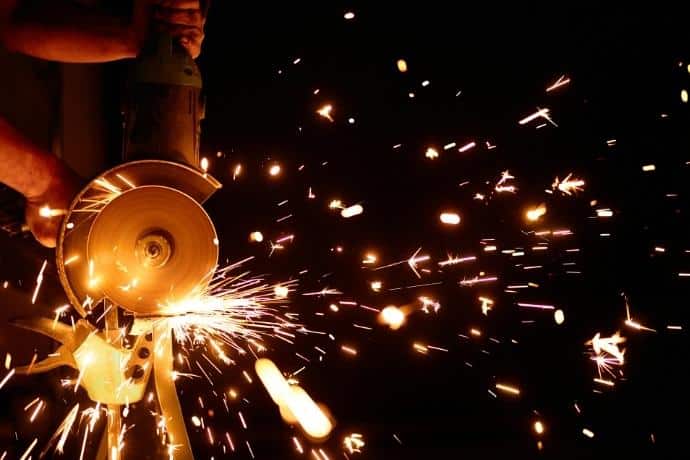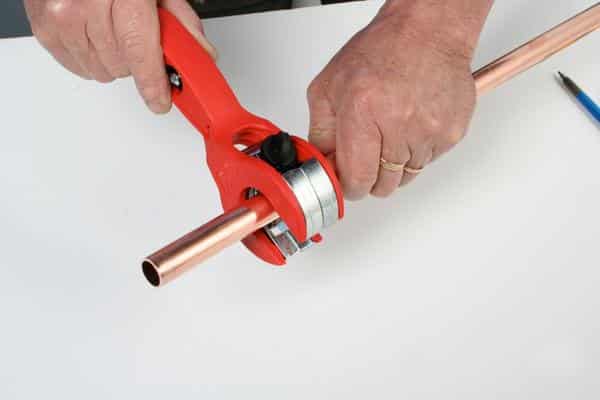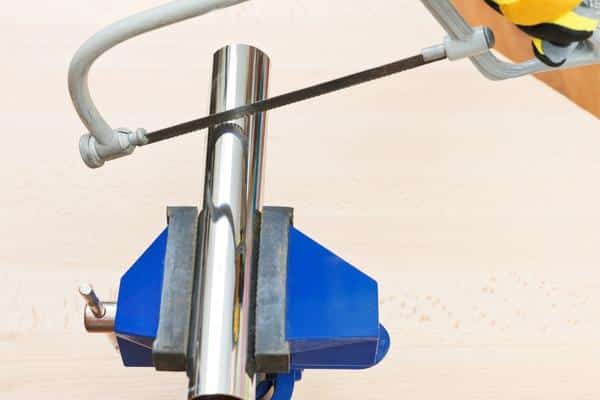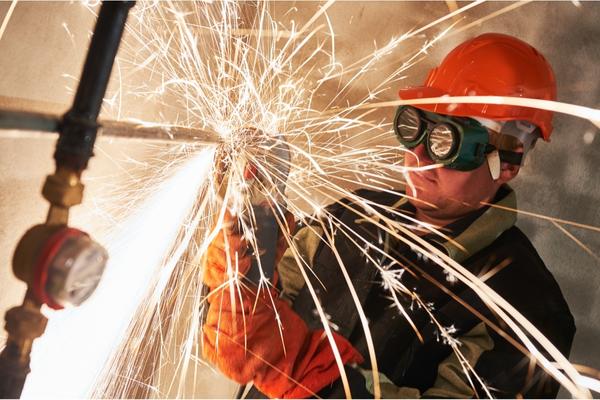
The Best Tool To Cut Metal Pipe
For metal pipe cutting, you have a few tool options at your disposal.
Tube/Pipe Cutting Tool
Not something everybody will have in their tool kit already, but if you intend to cut metal pipes regularly, it’s worthwhile considering investing in one. A tube cutting tool, or machine, offers a precise way of cutting metal pipe, but unlike the other tools we mention, this is its sole purpose. With two rollers and a cutting wheel, you can achieve a clean and exact cut every time. That said, this tool won’t be of much use if the pipe is already in situ in a hard-to-reach place. You need to be able to place the loose pipe in the machine for the cutting action.
Angle Grinder for Cutting Metal Tubing
Power tools are always useful when cutting through metal. An angle grinder is especially handy if you need to cut an old pipe from a tight space. Angle grinders are also more than capable of cutting through the more commonly found copper and cast iron pipes. This method will require the most safety equipment. Safety goggles, protective gloves, and earplugs are advisable. Ensure you choose the right cutting disc for metal, a blade with smaller tines will make light work of even the toughest pipes.
Using a Saw To Cut Metal Pipe
A hacksaw may not always be the best option to cut a metal pipe, but it’s certainly something we all have in our tool kits. The pipe will need to be secured before cutting, so not ideal for pipes that are already installed.
However, cutting metal pipe with a reciprocating saw would be a faster and less strenuous option — if the pipe is already located in a difficult-to-reach position.
What You’ll Need For This Tutorial
- Your tool to cut metal pipe— reciprocating saw, angle grinder, pipe cutting tool, or hacksaw.
- Pencil or chalk — to accurately mark where to cut.
- Clamp — to hold the pipe if loose.
- Safety gloves, eye protection.
- Tape measure — for accurate measurements.
- Metal file — to rub down any burr on the edges of the pipe.
- Tape — for marking the pipe when a pencil isn’t enough.
What You’ll Need for This Tutorial
Almost time to get wrapping, but let’s make sure you have all the equipment you need first:
- Digital or electric heat shrink gun.
- Fantail nozzle.
- Section of shrinkwrap — sufficient in size to completely wrap your object.
- Silicone or heatproof mat.
- Scissors or sharp crafting knife.
- Tape measure and/or ruler.
- Cleaning cloths.
- Fire extinguisher.
- Heat-proof gloves.
- Safety glasses.
How To Cut Metal a Pipe — Step-by-Step Guides
We’ve looked at the different pipe cutting saws/tools, let’s take a look at the method for each.
1. Reciprocating Saw
Step 1
If the pipe is in situ, disconnect the power and switch off the water to the pipe before starting the cut.Step 2
Using chalk or soapstone, mark where you want the cut to be.Step 3
Don your safety eyewear.Step 4
Secure the pipe. As the reciprocating saw blade moves back and forwards, it will tend to fling the pipe. Use either a vice/clamp to hold it in place or even secure it by clamping down hard with your own or a helper’s hand.Step 5
Line up your saw blade with the line you have marked. Begin cutting using a slow speed. Don’t apply too much downward pressure — this may cause the blade to slip and move towards you.Step 6
Continue until the reciprocating saw has completely cut through the metal pipe. A slow and steady movement will avoid the blade moving unpredictably.Step 7
If your Sawzall cannot completely cut through the pipe at either end, switch off the power. Allow the metal to cool down before trying again with either your reciprocating saw or change to a hacksaw for the final cut.Step 8
Using a metal file, smooth any burrs from the cut end of the pipe.
2. Tube Cutting Tool
Step 1
Take exact measurements and mark your cut line. Repeat this step for each pipe you’ll be cutting to save time before placing each length in the tool.Step 2
Place your pipe in the cutting tool. Line up the rollers and the cutting wheel with your cut point. Tighten to hold it securely.Step 3
Now, move the cutting tool around the pipe. The three points will rotate and make a precise cut.Step 4
Once cut, deburr the inside edges of your pipe/s.
3. Cut Copper Pipe With Angle Grinder
Step 1
Put on your safety equipment first.Step 2
Measure where you want to cut the pipe, and mark it.Step 3
If you’re cutting the pipe pre-installation, ensure it’s securely fixed to your work surface with a clamp. If the pipe is already in location, i.e. under a sink, make sure there are no obstacles in the way of the grinder. For tighter spaces, you may also want to consider using a reciprocating saw or Sawzall — if so, refer to the method above.Step 4
Before moving in to cut the pipe, ensure the grinding wheel is running. Allow the blade to speed up for a smoother finish, then move the blade to your target and make your cut.
4. Hacksaw
Step 1
Ensure the pipe is secure before cutting with a metal pipe saw. The back and forth sawing motion can cause the pipe to move as you work. Hence, the resulting cut will not be straight or precise unless you do so.Step 2
Support the longer end of the pipe, ready for when it drops as the cut is complete.Step 3
Patience, effort and stamina are key. Hacksaws take longer to cut through metal pipes, but you don’t need to apply too much pressure. A gentle and consistent motion as you saw while applying a moderate amount of force will result in a cleaner cut.Step 4
Using a metal file or sandpaper, you can clean up the cut end of the pipe to remove any burrs.How To Cut Metal Pipe — The Takeaway
How To Cut Metal Pipe FAQs
Q: How To Cut Metal Pipe Straight?
A simple hack is to attach a metal hose clamp around the part of the pipe to be cut and saw along the edge of the clamp — a perfectly straight edge every time!Q: Can You Use a Reciprocating Saw To Cut Steel Pipes?
Yes. Cutting galvanized pipe with a reciprocating saw is possible — providing you use a blade capable of carving through metal. The saw will provide a quick and clean cutting action that can handle any variety of thickness or diameter of the pipe.
Yet, this power tool is more than a metal pipe saw, if you want to learn more, check out my Reciprocating Saw Uses and How-to guide.










